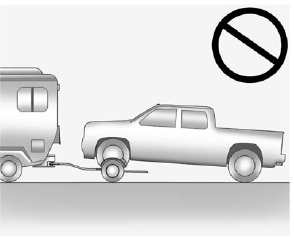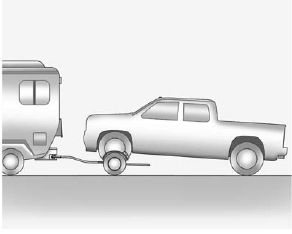Dolly Towing

Front Towing (Front Wheels Off the Ground) – Two-Wheel-Drive Vehicles
Notice: If a two-wheel drive vehicle is towed with the rear wheels on the ground, the transmission could be damaged.
The repairs would not be covered by the vehicle warranty. Never tow the vehicle with the rear wheels on the ground.
Two-wheel-drive vehicles should not be towed with the rear wheels on the ground. Two-wheel-drive transmissions have no provisions for internal lubrication while being towed.
To dolly tow a two-wheel-drive vehicle, the vehicle must be towed with the rear wheels on the dolly.
See “Rear Towing (Rear Wheels Off the Ground)” later in this section for more information.

Front Towing (Front Wheels Off the Ground) – Four-Wheel-Drive Vehicles
Use the following procedure to dolly tow a four-wheel-drive vehicle from the front:
1. Attach the dolly to the tow vehicle following the dolly manufacturer's instructions.
2. Drive the front wheels onto the dolly.
3. Shift the transmission to P (Park).
4. Firmly set the parking brake.
WARNING
Shifting a four-wheel-drive vehicle's transfer case into N (Neutral) can cause the vehicle to roll even if the transmission is in P (Park). The driver or others could be injured. Make sure the parking brake is firmly set before the transfer case is shifted to N (Neutral).
5. Use an adequate clamping device designed for towing to ensure that the front wheels are locked into the straight position.
6. Secure the vehicle to the dolly following the manufacturer's instructions.
7. Shift the transfer case to N (Neutral). See “Shifting into Neutral” under Four-Wheel Drive on page 9‑43 for the proper procedure to select the neutral position for the vehicle.
8. Release the parking brake only after the vehicle being towed is firmly attached to the towing vehicle.
9. Turn the ignition to LOCK/OFF.
After towing, see “Shifting Out of Neutral” under Four-Wheel Drive on page 9‑43.
See also:
Odometer
The odometer shows how far the vehicle has been driven, in either kilometers or miles. ...
The Inside
Here's where GM has really outdone itself in its new SUVs. Like the Tahoe,
the Yukon shows off one of the best interiors GM has ever mustered in a
mass-marketed vehicle. All the buttons are of abo ...
Driving on Grades
Reduce speed and shift to a lower gear before starting down a long or steep downgrade. If the transmission is not shifted down, the brakes might get hot and no longer work well.
Vehicles can tow in D ...





